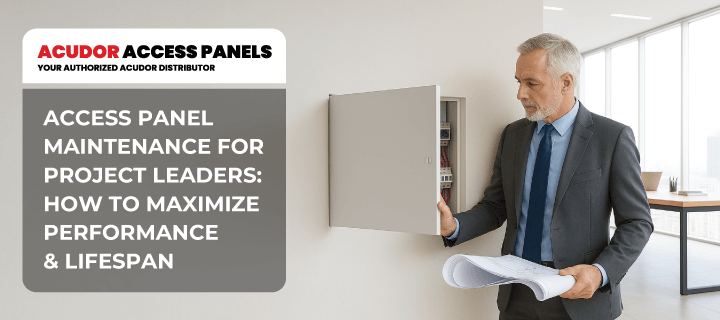Install an Acudor Roof Hatch in 5 Simple Steps Posted by Acudor Access Panels on 19th Dec 2024
A poorly installed roof hatch can lead to costly repairs, safety hazards, and energy inefficiency. Loose or unstable hatches pose serious safety risks, and poor sealing can increase energy bills. This can result in water leaks that can damage the building's interior and structural damage that can compromise the roof's integrity.
This article provides clear, actionable steps to ensure the successful installation of an Acudor roof hatch.
A 5-Step Guide to Installing Your Acudor Roof Hatch
Roof hatch installation can be a complex task, fraught with potential pitfalls. From safety concerns to technical intricacies, a misstep can lead to dire consequences.
Following these steps can prevent these mishaps and maximize your roof hatch's performance and longevity.
Step 1: Planning and Preparation
Before you start your roof hatch installation, it is crucial to select the right size and type of hatch for your specific needs. Consider the following factors:
- Roof Pitch: The angle of your roof will influence the type of hatch you need. Steep-pitched roofs may need specialized hatches with extra support.
- Load Capacity: Ensure the hatch can handle the weight of individuals accessing the roof and any equipment or materials that may be transported.
Check local building codes and regulations to ensure your roof hatch meets all safety and structural requirements.
Step 2: Prepare the Roof Opening
Before installation, accurately measure your roof hatch and mark the roof opening, ensuring it is slightly larger to accommodate flashing and sealant.
Cut the opening carefully, using the proper tool for your roof material. Prioritize safety by wearing protective gear and securing cut-out pieces. Clean the area thoroughly before proceeding to the next step.
Step 3: Install the Flashing
Properly installed flashing is essential to prevent water infiltration. Choose a high-quality flashing material compatible with your roof. Cut and secure the flashing around the roof opening, ensuring a tight fit. Use a quality sealant to seal all joints and seams.
Step 4: Install the Roof Hatch
Carefully position the roof hatch over the prepared opening, ensuring proper alignment with the roof and flashing. Use leveling shims to achieve a level installation.
Secure the hatch to the roof using the provided hardware, tightening the fasteners to prevent movement. Seal the edges with sealant to create a watertight seal. Finally, test the hatch's operation to ensure smooth opening and closing.
Step 5: Seal and Finish
To ensure a watertight seal, apply a high-quality sealant around the edges of the hatch. Clean the surface thoroughly before applying the sealant and smooth it out for a neat finish.
After the sealant has cured, inspect the hatch for leaks or damage. Test all features, including retractable ladders or skylights, to ensure they function properly.
Product Highlight: RHA-LA Ladder Roof Hatch - Aluminum
Traditional roof hatches, especially those badly installed, are often inefficient and unreliable. The RHA-LA ladder roof hatch - aluminum provides a durable, energy-efficient, and user-friendly solution to rooftop access. Its innovative design revolutionizes roof access, making it effortless and efficient.
The RHA-LA is a high-quality, weather-tight roof hatch designed for easy and efficient access to roof areas. Its double-skinned aluminum construction, insulated for temperature control, is exceptionally durable. A gas spring mechanism and self-latching lock make operation effortless and secure. The RHA-LA is a durable, reliable solution for various applications.
Why Should You Choose the RHA-LA?
- Durability and Longevity: The RHA-LA is built to withstand harsh weather conditions and heavy use, ensuring long-lasting performance.
- Easy Operation: The gas spring-assisted opening mechanism allows for effortless one-handed operation, saving time and effort.
- Weather-tight Seal: The double-skin construction and weather-tight seals prevent leaks and drafts, keeping best indoor conditions.
- Energy Efficiency: The insulation in the RHA-LA helps reduce energy loss, contributing to lower utility costs.
- Safety and Security: The self-latching stainless-steel lock provides secure access to roof areas, minimizing risks.
Besides the RHA-LA, Acudor also offers a variety of access solutions, like the GFRG-R ceiling access door. This eco-friendly access door provides easy access to components behind wall surfaces while keeping a clean and modern aesthetic. It is perfect for both residential and commercial applications.
Elevate your projects with the RHA-LA. Request a quote today and experience a durable, efficient, secure access solution for your next project.
Conclusion
By following these steps, you ensure a safe, efficient, and durable roof access solution. Remember to regularly inspect your roof hatch for any signs of wear and tear and perform necessary maintenance to keep it in the best condition.
For more detailed information and specific instructions, visit our blog or call (888) 622-8367. Our team is equipped to answer all your questions. You can also explore other high-quality building products from Acudor Access Panels to enhance your projects.
Acudor Access Panels is a trusted and authorized distributor of Acudor products. We are proud to bring you their full range of industry-leading access doors and panels.





